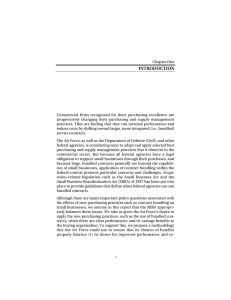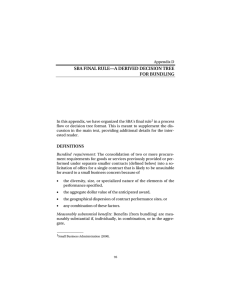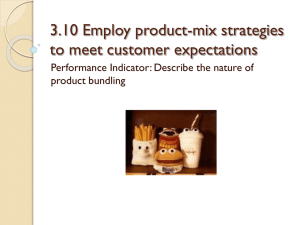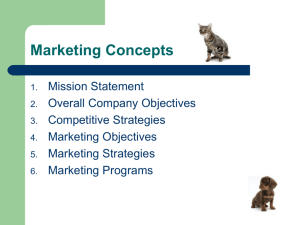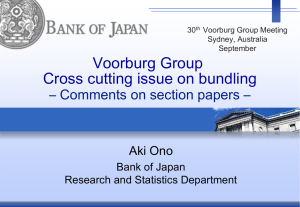RELEVANT LEGISLATION AND SKILLS
advertisement
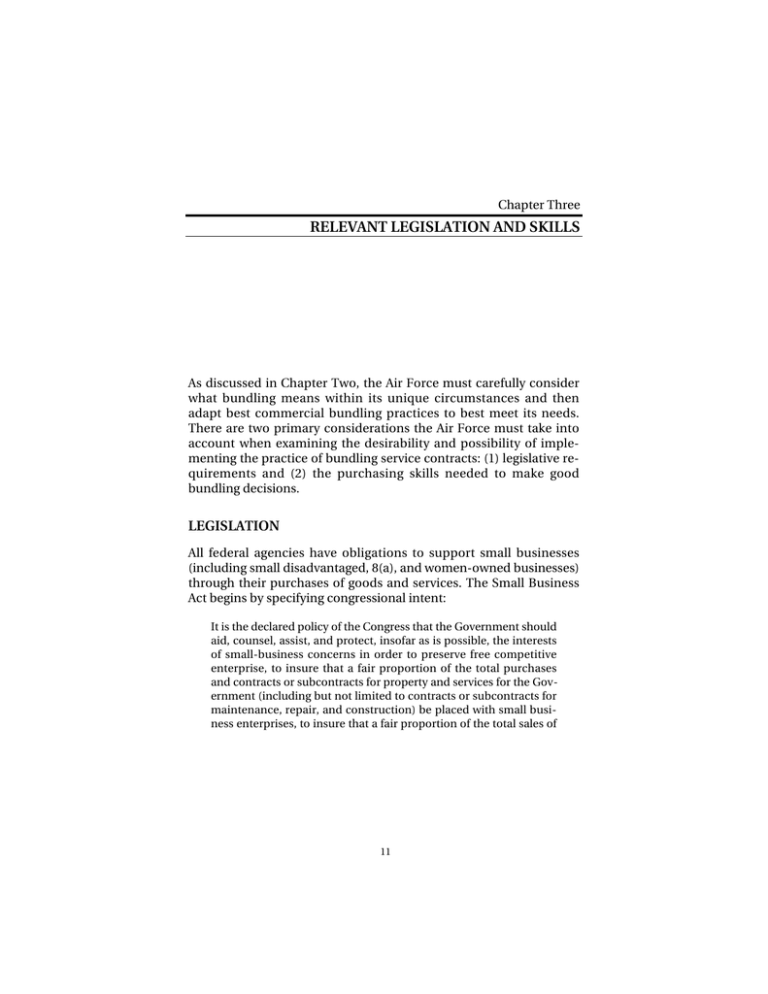
Chapter Three RELEVANT LEGISLATION AND SKILLS As discussed in Chapter Two, the Air Force must carefully consider what bundling means within its unique circumstances and then adapt best commercial bundling practices to best meet its needs. There are two primary considerations the Air Force must take into account when examining the desirability and possibility of implementing the practice of bundling service contracts: (1) legislative requirements and (2) the purchasing skills needed to make good bundling decisions. LEGISLATION All federal agencies have obligations to support small businesses (including small disadvantaged, 8(a), and women-owned businesses) through their purchases of goods and services. The Small Business Act begins by specifying congressional intent: It is the declared policy of the Congress that the Government should aid, counsel, assist, and protect, insofar as is possible, the interests of small-business concerns in order to preserve free competitive enterprise, to insure that a fair proportion of the total purchases and contracts or subcontracts for property and services for the Government (including but not limited to contracts or subcontracts for maintenance, repair, and construction) be placed with small business enterprises, to insure that a fair proportion of the total sales of 11 12 Federal Contract Bundling Government property be made to such enterprises, and to maintain and strengthen the overall economy of the Nation. (Sec. 2(a))1 Although no explicit preference for prime contracting (as opposed to subcontracting) opportunities for small businesses is expressed here, the Small Business Act was amended by the Small Business Reauthorization Act of 1997 to state that federal agencies should “avoid unnecessary and unjustified bundling of contract requirements that precludes small business participation in procurements as prime contractors” (Sec. 2(j)(3)). Apparently, Congress reevaluated its position on this issue as federal agencies began to change their purchasing practices and moved toward larger contracts. 2 Many small businesses do not have the capabilities to self-provide or even manage the entire workscope associated with large, bundled contracts. Their primary opportunities to participate in bundled contracts are through subcontracting arrangements with large prime contractors.3 In addition to the SBRA, the Competition in Contracting Act (CICA) of 1984 also affects the ability of federal agencies to consolidate their demands for services into large, bundled contracts. We discuss the nature of both of these Congressional requirements below. Small Business Reauthorization Act of 1997 Sections 411 through 413 and 415 of the SBRA (now Sections 2(j), 3(o), 8(d)(4)(G), and 15(e) of the Small Business Act) address the ability of federal agencies to consolidate their requirements into bundled contracts. This legislation defines bundling of contract requirements as the consolidation of two or more requirements for goods or services that were previously purchased through separate smaller contracts4 into a single solicitation that is unlikely to be suit______________ 1Quoted from the most recent version of the Small Business Act, amended August 17, 1999. 2See Romney (1998). 3Forming alliances with other provider firms (large or small) provides another opportunity for participation; however, we have been told that successfully creating and sustaining such teaming arrangements can be difficult and costly owing to transaction costs and coordination/management challenges. For example, see Romney (1998). 4A separate smaller contract is defined as a contract that was awarded to a small business or was suitable for such award (Sec. 412). Relevant Legislation and Skills 13 able for award to a small business.5 In particular, this legislation requires federal agencies to conduct market research to determine if consolidation is “necessary and justified” (Sec. 413), i.e., are the benefits, which are interpreted broadly to include cost savings and a variety of dimensions of performance improvements such as enhanced quality, “measurably substantial” relative to an unbundled baseline (Sec. 413). In addition, justification of a bundle based on pure administrative or personnel savings (e.g., fewer buyer staff to manage contracts) requires a different, potentially more strenuous, standard of proof. These benefits must be “substantial” in relationship to the value of the contract (Sec. 413). For workscopes considered to represent “substantial bundling” (Sec. 413), the federal agency must identify in the acquisition strategy the specific benefits from bundling, any barriers to participation by small businesses as prime contractors, and actions to maximize small business subcontracting opportunities. The agency must also include a determination that the specified benefits justify the use of a substantially bundled contract. On July 26, 2000, the SBA issued a final rule outlining how the SBRA should be interpreted and implemented. SBA’s Final Rule The SBA’s final rule lays out a process by which agencies can seek approval for bundled solicitations and defines the key terms that were left undefined in the SBRA. It also describes the SBA’s right to appeal bundled acquisition strategies that it feels do not meet the legislation’s guidelines. We discuss the main points of this approval process, with an illustration (see Figure 3.1) and definitions of the key terms for this process. Appendix D more fully explains the SBA’s final rule. Suppose a federal agency is considering a solicitation for one or more services. The first question the buying agency must answer is whether the SBRA justification guidelines apply to this solicitation. ______________ 5The bundle may be unsuitable for award to a small business because of one or more of the following reasons: the way the performance requirements are specified (e.g., diversity, size, or specialization), the total dollar value of the award, or geographic dispersion of sites where the services will take place (Sec. 412). 14 Federal Contract Bundling RAND MR1224-3.1 Are you bundling a requirement? No Yes Is this exempt from OMB Circular A-76? STOP — SBRA does not apply No Yes, SBRA applies Conduct market research Is average annual contract value ≥ $10M? No Yes Include analysis to show that bundling is necessary and justified Assess impediments to small business participation as prime contractors Identify actions to maximize small business participation as prime contractors Identify actions to maximize small business participation as subcontractors Is the total contract value ≤ $75M? No Yes Are benefits only from administrative or personnel savings? No Are $ benefits ≥ max (5%, $7.5M)? No Yes Yes Are $ benefits ≥ 10%? Has the Service Acquisition Executive determined that the bundle is necessary and justified? No Yes Does the PCR* agree that the bundled requirement is necessary and justified? No STOP — Unbundle requirement Yes No — SBA appeals *PCR = procurement center representative Yes Go to solicitation Figure 3.1—Bundling Justification Decision Tree Relevant Legislation and Skills 15 They apply if (1) the solicitation represents a bundled requirement (as defined above) and (2) the solicitation is for a recontracting activity. Solicitations conducted according to the rules of the OMB Circular A-76 are exempt.6 If the SBRA applies, the buying agency is required to conduct market research to determine whether the bundled requirement is necessary and justified. A bundled requirement is considered to be necessary and justified if the cost and performance benefits associated with bundling are measurably substantial, relative to a baseline of separate smaller contracts. (The unbundled baseline for documenting benefits is the costs charged by small businesses for the pieces of the bundled workscope that they provide and, to the extent that they are available, the costs that could have been or could be charged by small businesses for the remaining portion of the workscope.) Performance benefits must be converted into dollar savings terms to count.7 If the total contract value (including options) is $75 million or less, then benefits must equal at least 10 percent of the total contract value to be considered measurably substantial. If the total contract value (including options) is greater than $75 million, benefits must equal at least 5 percent of the total contract value or $7.5 million, whichever is greater, to be considered measurably substantial. When justifying a bundle based on only administrative or personnel cost savings, savings must equal at least 10 percent of the total contract value (including options), regardless of the contract size, to be considered measurably substantial.8 If market research shows the bundled requirement to be necessary and justified, the next question the buying agency must answer is ______________ 6The SBA’s final rule asserts that if a group of activities is outsourced through the A-76 cost comparison process, the methodology will have ensured that the federal agency will derive “measurably substantial benefits” from the bundle. 7An interim rule, issued October 25, 1999, discusses a lack of comparability among the types of cost and performance benefits allowed by the SBRA. The requirement that all anticipated bundling benefits be expressed in terms of dollars is a way to address this. As an example, a reduction in cycle time associated with bundling must be converted to the value in dollars to the buying agency for that benefit to count. 8 Note that benefits need only be quantified and monetized up to the appropriate threshold. A complete assessment of the levels of all benefits may not be necessary. 16 Federal Contract Bundling whether the requirement represents an average annual contract value of $10 million or more. 9 If so, this is a substantially bundled requirement. As a result, the acquisition strategy must be expanded to include (1) an analysis indicating that the bundle is necessary and justified, (2) an assessment of impediments to small business participation as prime contractors, (3) actions to maximize small business participation as prime contractors, and (4) actions to maximize small business participation as subcontractors. If market research does not show that the bundled requirement is necessary and justified according to the benefit thresholds noted above, then the Service Acquisition Executive can determine that the bundle is necessary and justified when it is critical for the buying agency to meet its mission.10 If the Service Acquisition Executive is unwilling to make this determination, the buying agency must proceed with an unbundled acquisition strategy. For a necessary and justified bundle (whether demonstrated through market research or determined by the Service Acquisition Executive), the last important question the buying agency must answer is whether the SBA’s procurement center representative (PCR) agrees that the bundle is necessary and justified and, for a substantially bundled requirement, approves of the actions to promote small business participation as prime and subcontractors. If so, the agency can proceed to the solicitation. If not, the PCR can appeal the bundled acquisition strategy to the head of the contracting activity and then to the service secretary, if necessary.11 ______________ 9For example, suppose the workscope of a five-year contract with two option years is planned to expand each year, adding an additional $1 million to the contract price annually. If the cost of the first year’s workscope is $5 million, then the total contract value over the seven years is $56 million, and the average annual value is $8 million. 10The Under Secretary of Defense for Acquisition and Technology can perform this function for other defense agencies, and the Deputy Secretary or equivalent can perform this function for civilian agencies. 11A proposed bill, The Small Business Contract Equity Act of 2000 (H.R. 4890), would amend the bundling appeal process, giving decision authority to the Director of the Office of Management and Budget. Relevant Legislation and Skills 17 Competition in Contracting Act of 1984 Although our primary focus in this research is the SBRA, CICA, which seeks to maximize competition for federal contracts, may also limit the ability of federal agencies to bundle goods and services into large, integrated contracts. This legislation would apply if it is perceived that a bundled contract has limited the pool of bidders so that the requirements cannot be filled at the lowest possible cost.12 NEW SKILLS As we have seen through related RAND research,13 organizations that have effectively implemented new PSM practices such as bundling and strategic supply-base reduction have made significant investments in new skills for the personnel executing these practices. In particular, conducting effective ongoing market research for specific classes of goods and services to understand the best sourcing practices plays a key role in bundling decisions. Although the Air Force is beginning to implement selected new PSM practices, it currently has little in-house expertise to understand (1) the sources of bundling benefits, which inform decisions about which services should be bundled into large contracts, and (2) how to measure the levels of benefits associated with bundling to demonstrate to the SBA that ______________ 12When the Air Force competed the Sacramento Air Logistics Center (ALC) workload in preparation for closure of McClellan Air Force Base, it bundled together KC-135 depot-level maintenance and modification activities, A-10 analytical condition inspections, paint, drop-in maintenance actions, and repair for commodities. Pemco Aeroplex Corporation, the firm that previously performed the KC-135 workload, chose not to participate in the competition due to its scope and protested the bundle to the General Accounting Office (GAO), asserting that the bundle violated CICA. The GAO agreed that the Air Force had not adequately justified the bundle, but the Air Force refused to unbundle the workload and recompete it. See GAO (1998) and Costa (Jauary 1999 and May 1999). For a general discussion of CICA and bundling issues, see GAO (1999). 13Nancy Y. Moore, Laura H. Baldwin, Frank Camm, and Cynthia Cook discussed the challenges commercial buyers have faced in increasing the skills of their purchasing personnel, how they have addressed these challenges, and implications for the Air Force in a 1999 briefing, “Implementing Best Purchasing and Supply Management Practices: Lessons from Innovative Commercial Firms.” 18 Federal Contract Bundling these benefits exceed the threshold established by the SBA in its final rule as a result of the SBRA.14 ______________ 14In the context of public/private competitions conducted under the OMB Circular A-76 rules, Air Force personnel have expressed concerns that functional personnel may not have the experience/skills needed to construct statements of work for bundled studies. This can be especially difficult if those personnel are participating in study teams on a part-time basis, with little reduction in their “normal” duties. In addition, the government-employed civilians charged with the responsibility of creating the in-house bid, called the Most Efficient Organization (MEO), for a bundle of services may lack the skills needed to reorganize the provision of bundled services more efficiently across traditional organizational boundaries. Because the MEO is much less likely to successfully compete against external providers without such a reorganization of the bundled workload, the Air Force also faces internal resistance to bundled A-76 studies.
